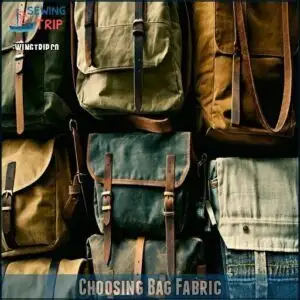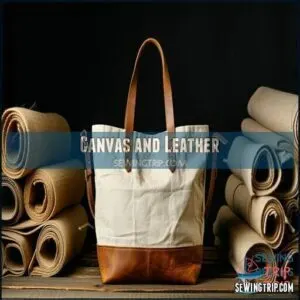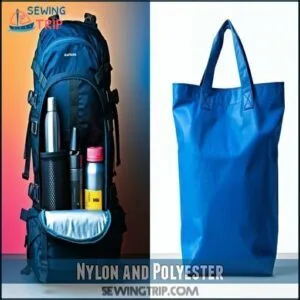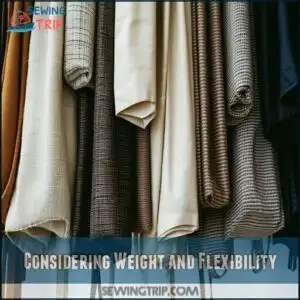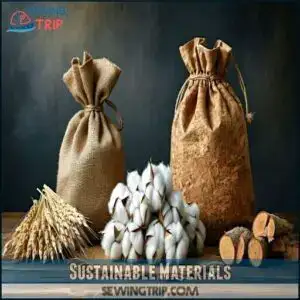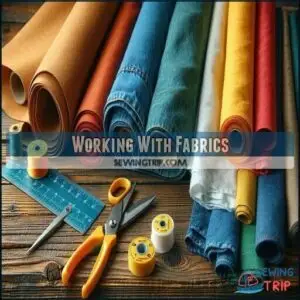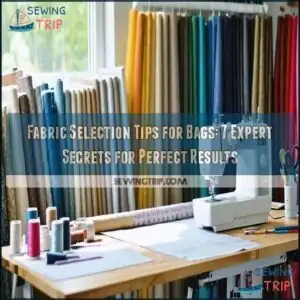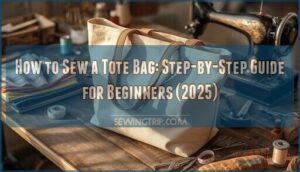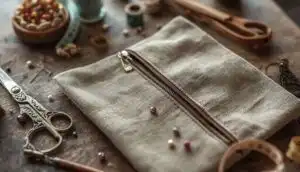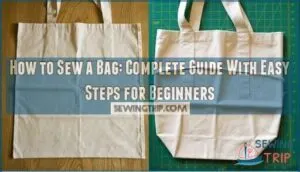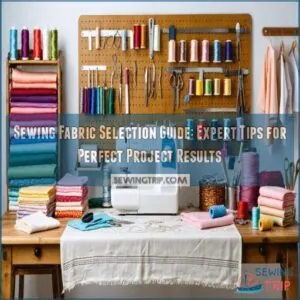This site is supported by our readers. We may earn a commission, at no cost to you, if you purchase through links.

Canvas is a classic choice—it’s tough, versatile, and easy to sew. If you’re aiming for elegance, leather adds a sleek, high-end finish but can be trickier to work with.
For lightweight, water-resistant options, nylon and polyester are lifesavers, especially for travel or gym bags. Denim offers a casual, sturdy vibe, while synthetic leather mimics the look of genuine leather without the cost.
Don’t forget interfacing and interlining to add structure. The perfect bag starts with the right fabric—exploring weights, textures, and blends makes all the difference.
Table Of Contents
Key Takeaways
- Pick fabrics based on your bag’s purpose—canvas for durability, nylon for water resistance, and leather for a premium look.
- Use interfacing and reinforcements like double stitching or bar tacks to ensure structure and strength.
- Match closures, linings, and hardware to your bag’s function and style for a polished, professional finish.
- For outdoor or weatherproof bags, go with materials like treated canvas or waterproof nylon for durability and protection.
Choosing Bag Fabric
You’ll need to take into account durability, intended use, and maintenance requirements when selecting fabric for your next bag project, as the right material forms the foundation for both functionality and visual appeal.
Canvas offers sturdy structure for everyday totes while specialty fabrics like water-resistant nylon prove essential for outdoor applications, ensuring your handmade creation withstands its intended purpose, which is based on its intended use.
Durability and Longevity
When choosing a durable bag material, focus on fabric strength and abrasion resistance.
Heavy-duty bag fabric like canvas or Cordura guarantees load capacity and long-term use.
Reinforce seams to handle weight and prevent tearing.
Opt for materials with weather protection, like treated nylon, to withstand elements.
Fabric durability is key for creating a reliable, hardwearing bag.
Style and Aesthetics
When it’s about bag aesthetics, let color palettes and texture combinations tell your story.
Think of bold fabric prints or soft fabric colors that suit your style.
Pattern matching enhances visual harmony, giving your bag design a polished feel.
Incorporate fabric embellishments to transform bags into fashion accessories.
Every detail works together to create a standout piece.
Maintenance and Care
Caring for your bag material guarantees its longevity. Here’s how:
- Stain Removal: Treat spills quickly with fabric-safe cleansers.
- Washing Instructions: Check labels; hand-wash delicate materials.
- Storage Solutions: Use dust bags to prevent wear.
- Repair Techniques: Reinforce small tears early to retain fabric strength.
- Protecting Fabrics: Spray water-resistant coatings to enhance durability.
Purpose and Intended Use
Each bag fabric excels in specific areas.
Planning a travel bag? Durable, water-resistant nylon is essential. For daily use, choose lightweight canvas for functionality.
Outdoor gear demands tough Cordura nylon, while formal events shine with sleek faux leather.
For everyday totes, consider canvas for durability.
Here’s a handy guide:
| Purpose | Recommended Fabric | Key Feature |
|---|---|---|
| Daily Use | Canvas | Lightweight, durable |
| Outdoor Gear | Cordura Nylon | Abrasion-resistant, strong |
| Travel Bags | Ripstop Nylon | Water-resistant, compact |
| Formal Events | Faux Leather | Stylish, professional look |
| Specific Activities | Recycled Polyester | Eco-friendly, versatile |
Fabric Types and Uses
When selecting fabric for your bag, it’s important to understand how each type suits specific uses and needs.
From sturdy canvas to sleek leather and versatile synthetics, each material offers unique benefits that impact the bag’s durability, style, and functionality.
Canvas and Leather
Canvas offers unmatched durability, making it a go-to for everyday bags. Pair it with leather for timeless aesthetics and strength.
Leather adds luxury and versatility, elevating your bag designs. Fabric paint can also enhance these materials, providing unique color vibrancy.
- Combine canvas and leather for classic, durable styles.
- Opt for ethically sourced leather for sustainable bag making.
- Leverage these materials’ strengths for tote bags, backpacks, and more.
Nylon and Polyester
When stepping into synthetics, nylon and polyester are shining stars for long-lasting bags.
Nylon boasts durability and flexibility, perfect for adventure-ready backpacks. Polyester stands out with color retention and wrinkle resistance, ideal for stylish bags.
Consider nylon fabric options for specialized needs. Choose wisely, considering denier differences and fabric coatings for waterproof bag fabric.
This backpack fabric guide highlights why synthetic blends dominate bag making.
| Feature | Nylon Durability | Polyester Properties |
|---|---|---|
| Strength | Highly durable | Strong, UV-resistant |
| Flexibility | Excellent | Moderate |
| Water Resistance | High | Moderate, depends on coating |
| Best Use | Outdoors, sports bags | Everyday, affordable bags |
| Cleaning Ease | Easy | Quick-drying |
Specialty Fabrics
Sometimes, fabric for bag making goes beyond the basics.
Specialty fabrics like Harris Tweed add elegance, while Faux Suede brings softness and style.
Tartan Matching is perfect for polished designs but requires precision.
Cork Fabrics are lightweight and eco-friendly, and upcycled fabrics transform scraps into art.
Pair natural fabrics with synthetic ones for unique, durable bags with standout aesthetics, using techniques like Tartan Matching.
Fabric Selection Guide
Selecting the right fabric for your bag guarantees it’s functional, durable, and fits your style.
By considering factors like weight, cost, and sustainability, you can make choices that match your project perfectly.
Considering Weight and Flexibility
When sewing bags, fabric weight and flexibility play pivotal roles in design and durability.
A heavier fabric, like canvas, guarantees sturdiness, while lighter fabrics add versatility.
Consider fabric drape and hand—stiff materials aid bag structure, but softer ones fit casual needs.
This fabric guide reminds you: match weight impact and flexibility needs to create functional, stylish bags easily, ensuring a perfect blend of durability.
Budget and Cost Considerations
While understanding weight and flexibility is key, your budget shapes material choices.
Opting for upcycled fabrics can keep costs down and add character to your bag. Explore bulk discounts for affordable alternatives like polyester or nylon.
Consider visiting local stores for discounted remnant bins to find unique, cheap materials.
DIY options save money, but balance affordability with quality. Remember, in bag making, a smart cost-quality tradeoff guarantees both stunning looks and lasting durability.
Sustainable Materials
Think beyond price tags—embrace eco-friendliness with recycled materials. Recycled PET bags repurpose plastic bottles, offering durability.
Organic cotton, free from harmful pesticides, marries strength with sustainability. Hemp adds breathability and strength, while cork’s water resistance makes it a leather alternative.
Online Marketplaces and Selection
Exploring sustainable materials naturally leads us to online marketplaces—your gateway to bag fabrics, hardware, and more.
From ShabbyFabrics.com to Amazon, each platform offers unique perks.
| Marketplace | Focus Products | Perks | Shipping Options |
|---|---|---|---|
| Shabby Fabrics | Tote kits, fabrics | Free U.S. shipping $75+ | International available |
| Country Cow Designs | Patterns, hardware | Versatile selection | Worldwide shipping |
| Emmaline Bags | Hardware, fabric | High-quality niche items | International shipping |
| Amazon | Canvas bags | Budget-friendly prices | Extensive delivery options |
Many consumers now buy bag material from online vendors, which is a convenient option for those looking for high-quality materials. Check seller reputation to verify fabric authenticity, ensuring you get the best products for your needs, and consider the shipping options carefully to avoid any issues.
Working With Fabrics
When you’re working with fabrics for sewing bags, it’s all about striking the right balance between functionality and style.
From choosing suitable interfacing to picking the perfect thread, every detail affects the bag’s durability and finish.
Interfacing and Interlining
Choosing the right interfacing and interlining brings structure and strength to your bag.
It guarantees your creation holds its shape and lasts longer.
- Fusible options bond easily to fabric for quick stabilization.
- Sew-in interfacing is great for delicate fabrics requiring extra care.
Use stabilizer types based on your bag’s fabric weight and intended function.
Quilting Techniques
Every stitch counts with quilting techniques in bag making.
Quilting patterns and batting choices stabilize fabrics, while adding texture and strength.
Use quilting cotton for intricate designs or blend fabrics for unique looks.
Stitch evenly for durability.
Pair creativity with precision—your bag will reflect your craftsmanship.
| Technique | Purpose | Key Material | Tip |
|---|---|---|---|
| Straight-line quilt | Adds clean texture | Quilting cotton | Mark lines with chalk |
| Grid quilting | Even strength, symmetry | Blended bag fabrics | Use a walking foot |
| Free-motion quilting | Creative expressions | Stabilized fabrics | Practice swirls on scraps |
| Stitch-in-the-ditch | Seam stability | Pre-quilted materials | Match thread to fabric color |
Thread Choice and Needle Selection
After quilting enhances structure, it’s time to fine-tune your stitching.
Match thread weight with your fabric’s needs—heavier for canvas, lightweight for quilting cotton.
Needle types matter; sharp needles suit dense fabrics, while universal ones handle most tasks.
Balance sewing machine tension and adjust stitch length for seamless results, which guarantee flawless stitch type visibility and durable stitching techniques.
Fabric Sourcing and Cost
Fabric sourcing starts with smart choices like wholesale fabric for bulk purchasing or finding gems at discount retailers.
Explore fabric remnants for budget alternatives or upcycled materials for sustainability.
Consider local suppliers and online marketplaces to compare options, building manufacturer relationships guarantees consistent access to materials.
Always keep a contingency budget ready to handle unforeseen costs in your sourcing journey, ensuring you can navigate challenges with smart choices.
Bag Making Essentials
To create a bag that’s both functional and stylish, you’ll need to start with the right essentials like lining fabrics, zippers, and hardware.
By focusing on sturdy seams, proper closures, and refined finishing techniques, you can guarantee your bag stands out with a professional touch.
Lining Fabrics and Hardware
When crafting the perfect bag, don’t overlook linings and hardware.
A durable lining enhances both style and function. Hardware choices like magnetic snaps, buckles, and D-rings add polish and practicality.
Consider these essentials:
- Lining Durability for wear resistance.
- Versatile Hardware Types for any style.
- Bag Hardware Supplies like rectangle rings.
- Interfacing for Bags for added structure.
Selecting the right lining can substantially impact long term bag use.
Zippers and Closure Options
Choosing the right closure defines your bag’s look and function.
Explore zipper types for secure openings, from metal to invisible options. Magnetic snaps and buckle closures add elegance, while drawstring bags offer simplicity.
Velcro alternatives like buttons or clasps suit various bag making patterns. Stock up on bag hardware supplies to guarantee versatility for all your bag-making needs.
For a professional finish, consider using a zipper foot for precise stitching.
Reinforcing Seams and Stress Points
Strong seams make or break your bag’s durability.
Reinforce those stress points with these essentials:
- Double Stitching: Strengthen key areas like straps and corners.
- Zigzag or Bar Tack Stitches: Great for high-stress zones.
- Heavy-Duty Thread: Boosts fabric strength and sewing reliability.
- Hardware Integration: Rivets or grommets handle weight beautifully.
- Reinforcement Placement: Add patches or interfacing to long-lasting wear areas.
Finishing Techniques for Professional Look
Adding strong seams is just part of bag making—polished details complete it.
Use Edge Finishing techniques like bias tape or sergers for clean lines, and master Seam Concealment with French or bound options.
Lining Installation adds structure to fabric combinations, while Hardware Attachment demands precision.
Finish with neat Topstitching Tips to secure layers, enhancing both durability and elegance in bag construction.
Frequently Asked Questions (FAQs)
What is the best fabric for sewing bags?
Think of bag fabrics as tools in a craftsman’s kit—canvas shines for strength, nylon wins for water-resistance, and leather screams luxury.
Match fabric to purpose, ensuring durability, style, and functionality align with your design, and consider how each choice impacts the overall luxury of the final product.
How many meters of fabric do I need for a tote bag?
You’ll need about 75 to 1 meter of fabric for a standard tote bag, depending on its size and design.
If it includes pockets, linings, or straps, plan for slightly more fabric.
What is the best stitch to sew a bag?
Use a straight stitch for most of the bag, as it’s strong and versatile.
For added durability, reinforce stress points with a bar tack or backstitch, especially at straps, corners, and seams.
What material to make a bag out of?
Choose materials like durable canvas for everyday totes, luxurious leather for premium bags, or water-resistant nylon for outdoor backpacks.
Think about purpose, durability, style, and care to match your needs perfectly.
What fabrics provide the best weather resistance?
When it rains cats and dogs, fabrics like nylon, polyester, and treated canvas step up, offering excellent weather resistance.
They repel water and handle moisture well, making them perfect for outdoor bags and wet conditions.
How do different fabrics affect bag structure?
Different fabrics shape bags in unique ways.
Stiff materials like canvas hold structure well, creating sharp silhouettes, while softer fabrics like quilting cotton drape more, offering a relaxed look.
Factor material weight and purpose for balance.
Which fabrics are ideal for lightweight bags?
Lightweight fabrics like nylon, polypropylene non-woven, and quilting cotton work wonders for bags.
They’re durable yet easy to carry, perfect for casual use or shopping.
These fabrics blend practicality with style, offering endless design possibilities.
What fabric options are suitable for outdoor use?
For outdoor use, rely on durable fabrics like waterproof nylon or polyester, Cordura for abrasion resistance, and treated canvas for weatherproofing.
Each offers excellent strength, longevity, and protection against the elements, ensuring your bags endure rugged adventures.
How does breathability vary among bag fabrics?
Imagine your favorite backpack on a hot day—it breathes, or doesn’t.
Natural fabrics like cotton are breathable, while nylon and polyester trap heat.
But coated or laminated versions often sacrifice airflow for waterproofing.
Conclusion
Finding the perfect fabric for your bag is like building a strong foundation—it determines the durability, style, and functionality of your creation.
With this fabric guide for sewing bags, you’ve got the tools to balance tough, elegant, or lightweight materials based on your project’s purpose.
Consider fabric weight, texture, and cost, then pair them with proper interfacing and finishing touches for polished results.
With thoughtful choices, every bag you sew can be both beautiful and long-lasting.

